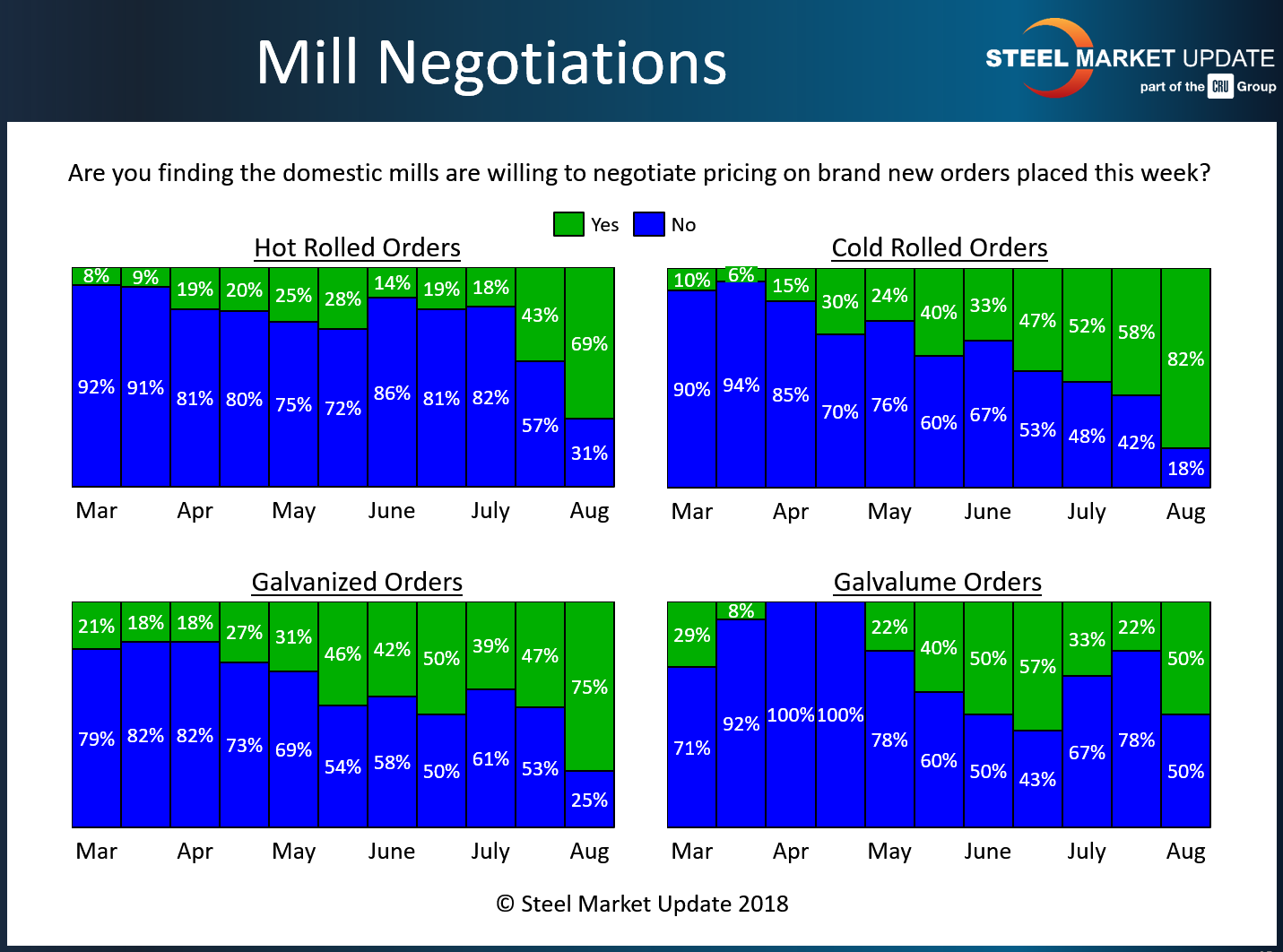SMU Data and Models

Steel Mill Negotiations: Price is in Play
Written by Tim Triplett
August 9, 2018
Negotiations between steel mills and buyers have loosened considerably as the mills appear significantly more willing to negotiate spot prices than at any other point this year.
Every two weeks, in a proprietary poll, SMU tracks how buyers and sellers of flat rolled steel represent the mill negotiation position. According to respondents to this week’s market trends questionnaire, 69 percent of hot rolled buyers said they have found mills willing to negotiate, up from just 18 percent in July. Just 31 percent said mills remain firm on price.
In the cold rolled segment, 82 percent said they have found some mills willing to talk price, up from a bit more than half a few weeks earlier. Just 18 percent of respondents reported mill prices on cold rolled as non-negotiable.
Likewise, prices on coated products appear to be in play. In the galvanized sector, 75 percent said the mills were open to price discussions, compared with 47 percent last month. In Galvalume, it’s a 50-50 proposition whether mills will negotiate with buyers.
If steel supplies in the U.S. tighten later this year as Trump’s tariffs kick in, the mills’ negotiation position could firm up once again. However, most steel buyers (and the futures market) are negative on steel prices over the next couple of months. With shorter lead times (as described in another article in tonight’s issue), the pressure to buy is being eased and steel buyers are waiting for and expecting better price offers in the weeks ahead.

Note: SMU surveys active steel buyers twice each month to gauge the willingness of their steel suppliers to negotiate pricing. The results reflect current steel demand and changing spot pricing trends. SMU provides our members with a number of ways to interact with current and historical data. To see an interactive history of our Steel Mill Negotiations data, visit our website here.

Tim Triplett
Read more from Tim TriplettLatest in SMU Data and Models

SMU Scrap Survey: Sentiment Indices rise
Both current and future scrap sentiment jumped this month, though survey participants reported responses before key trade news was announced.

SMU Survey: Sentiment splits, buyers have better view of future than the present
SMU’s Steel Buyers’ Sentiment Indices moved in opposite directions this week. After rebounding from a near five-year low in late June, Current Sentiment slipped again. At the same time, Future Sentiment climbed to a four-month high. Both indices continue to show optimism among buyers about their company’s chances for success, but suggest there is less confidence in that optimism than earlier in the year.

SMU scrap market survey results now available
SMU’s ferrous scrap market survey results are now available on our website to all premium members. After logging in at steelmarketupdate.com, visit the pricing and analysis tab and look under the “survey results” section for “ferrous scrap survey” results. Past scrap survey results are also available under that selection. If you need help accessing the survey results […]

SMU flat-rolled market survey results now available
SMU’s latest steel buyers market survey results are now available on our website to all premium members. After logging in at steelmarketupdate.com, visit the pricing and analysis tab and look under the “survey results” section for “latest survey results.” Past survey results are also available under that selection. If you need help accessing the survey results, or if […]

SMU Survey: Sheet lead times stabilize, plate contracts
Mill lead times for sheet products were steady to slightly longer this week compared to our late June market check, while plate lead times contracted, according to steel buyers responding to this week’s market survey.
